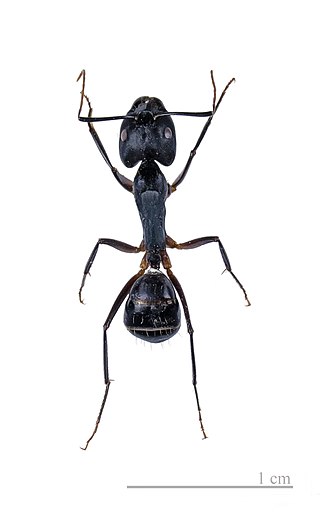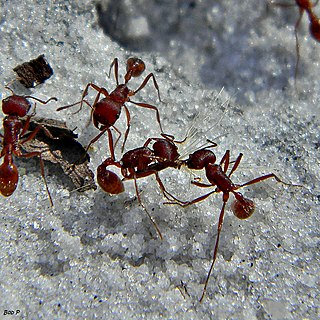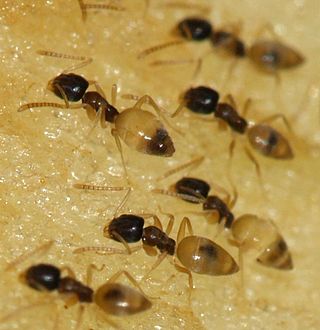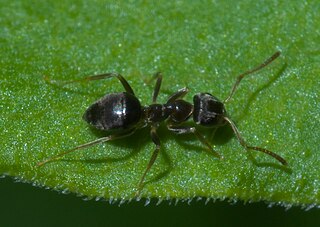
The Formicinae are a subfamily within the Formicidae containing ants of moderate evolutionary development.

Harvester ant, also known as harvesting ant, is a common name for any of the species or genera of ants that collect seeds, or mushrooms as in the case of Euprenolepis procera, which are stored in the nest in communal chambers called granaries. They are also referred to as agricultural ants. Seed harvesting by some desert ants is an adaptation to the lack of typical ant resources such as prey or honeydew from hemipterans. Harvester ants increase seed dispersal and protection, and provide nutrients that increase seedling survival of the desert plants. In addition, ants provide soil aeration through the creation of galleries and chambers, mix deep and upper layers of soil, and incorporate organic refuse into the soil.

Tapinoma is a genus of ants that belongs to the subfamily Dolichoderinae. The genus currently comprises 74 described species distributed worldwide in tropical and temperate regions. Members of are generalized foragers, nesting in a wide variety of habitats, ranging from grasslands, open fields, woodlands, to inside buildings. The majority of species nest in the ground under objects such as stones or tree logs, other species build nests under bark of logs and stumps, in plant cavities, insect galls or refuse piles.

Paratrechina is one of seven ant genera in the Prenolepis genus-group from the subfamily Formicinae. Six species are included in Paratrechina; one of which, the longhorn crazy ant, is a widespread, pantropical pest.

Myrmica is a genus of ants within the subfamily Myrmicinae. It is widespread throughout the temperate regions of the Holarctic and high mountains in Southeast Asia.

Liometopum is a genus of ants that belongs to the subfamily Dolichoderinae, found in North America, Europe and Asia.

Aenictus is a large army ant genus distributed in the Old World tropics and subtropics. It contains about 181 species, making it one of the larger ant genera of the world.
Euprenolepis echinata is a Southeast Asian species of ant in the subfamily Formicinae.
Euprenolepis maschwitzi is a Southeast Asian species of ant in the subfamily Formicinae.
Euprenolepis thrix is a Southeast Asian species of ant in the subfamily Formicinae.
Euprenolepis variegata is a Southeast Asian species of ant in the subfamily Formicinae.
Euprenolepis zeta is a Southeast Asian species of ant in the subfamily Formicinae.
Euprenolepis wittei is a Southeast Asian species of ant in the subfamily Formicinae.

Euprenolepis procera is a species of ant found in the rainforests of South East Asia. It was first described by Carlo Emery, an Italian entomologist, in 1900. In 2008, Witte & Maschwitz discovered that E. procera specialises in harvesting mushrooms in the rainforest for food, representing a new, previously unreported feeding strategy in ants.

Dilobocondyla is a genus of ants in the subfamily Myrmicinae. The genus is distributed in the Oriental and Australasian realms. It seems to be rare, with most species known only from single specimens.

Lordomyrma is a genus of ants in the subfamily Myrmicinae.

Euprenolepis is a Southeast Asian genus of ants in the subfamily Formicinae with eight recognized species.

Nylanderia is a large genus of ants in the subfamily Formicinae. The genus has a nearly cosmopolitan distribution with species inhabiting a wide array of habitats in almost all geographic regions. Nylanderia, currently containing over 110 species, is an ecologically important genus, with some species reported as being invasive. The ants are small to medium in size and range in color from pale yellow to black.

Liomyrmex is a monotypic genus of ant in the subfamily Myrmicinae; the type species is L. gestroi. This genus is known to inhabit Southeast Asia, South Asia, and parts of Southern China. Individuals in this genus are blind and are known to live among termites in their chambers, but it is relatively unknown as to the purpose of such a relationship.

Lasiini is a tribe of ants in the family Formicidae. There are about 10 genera and more than 450 described species in Lasiini.












